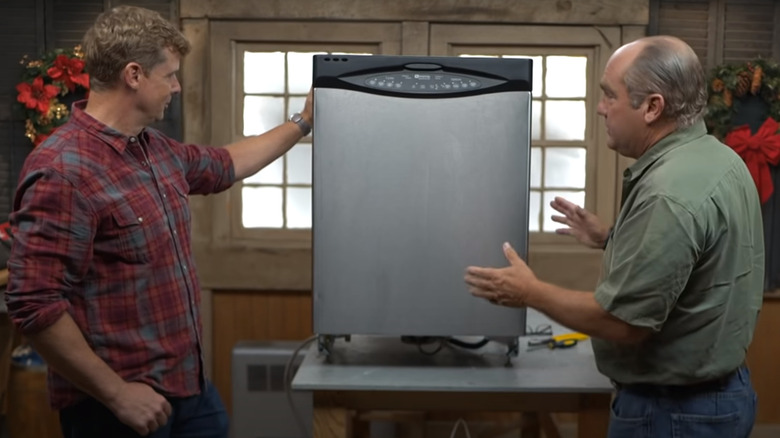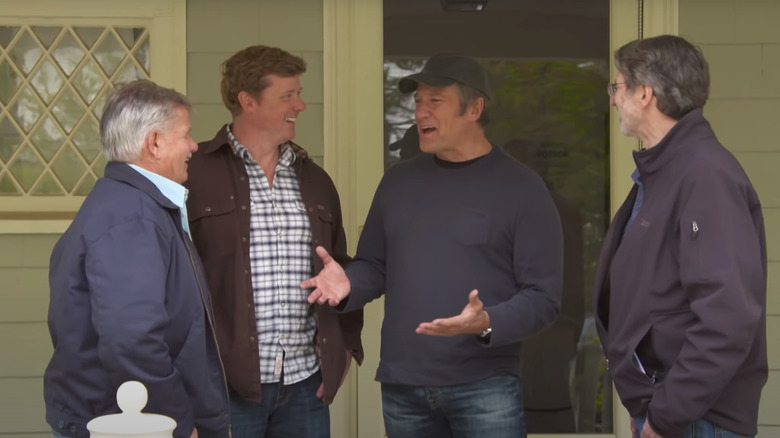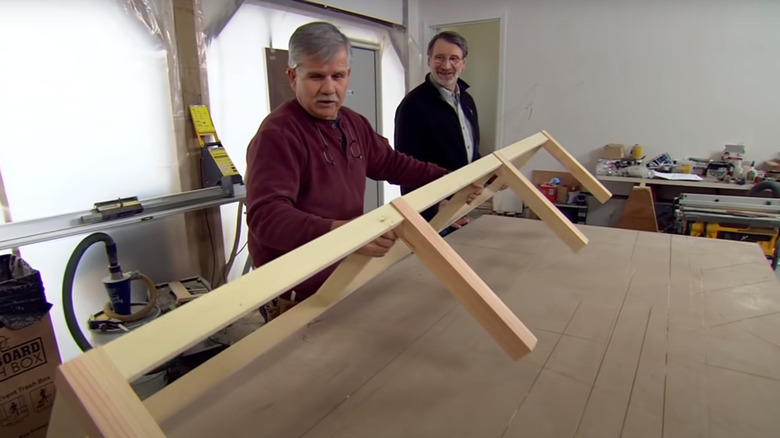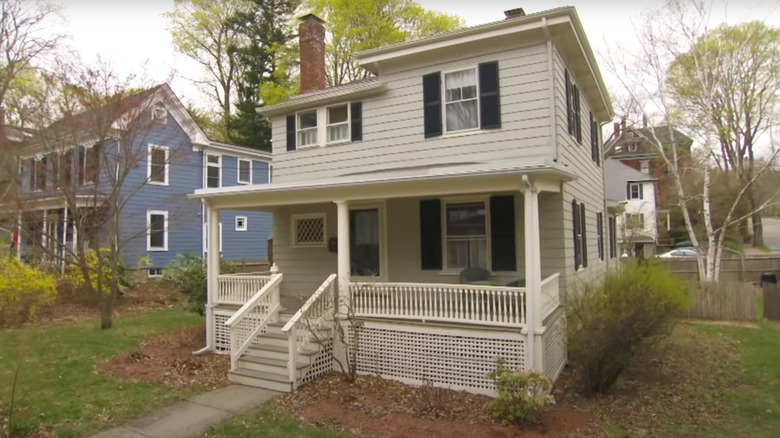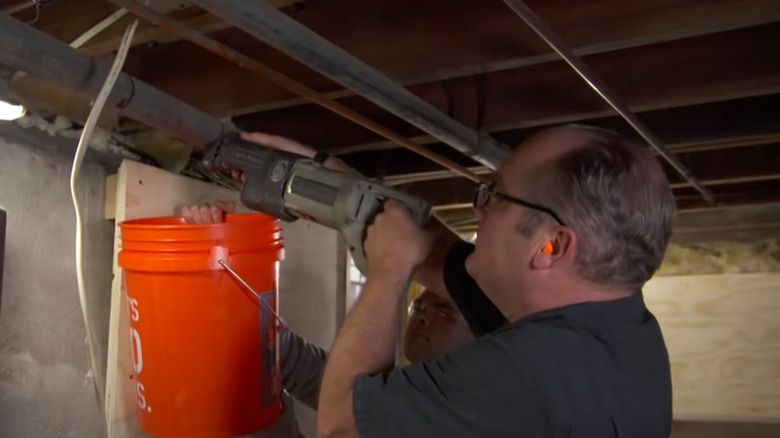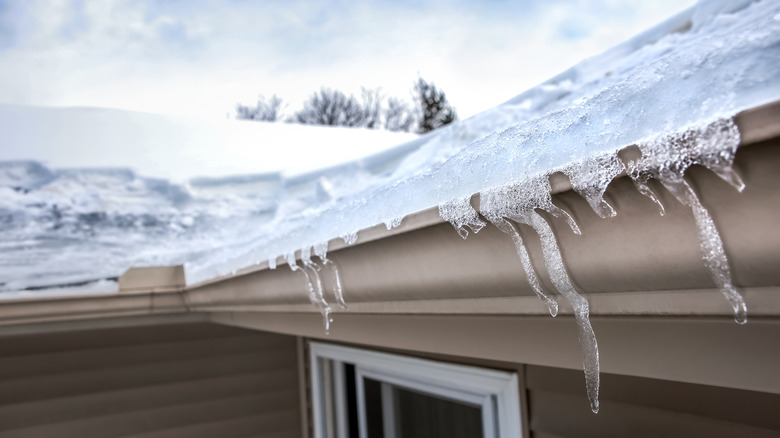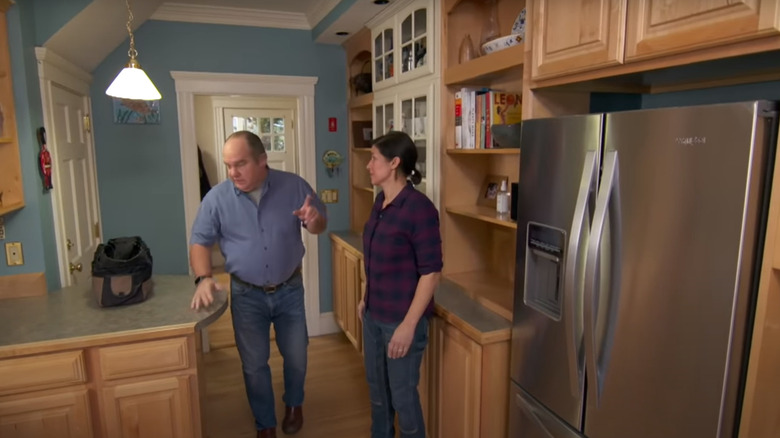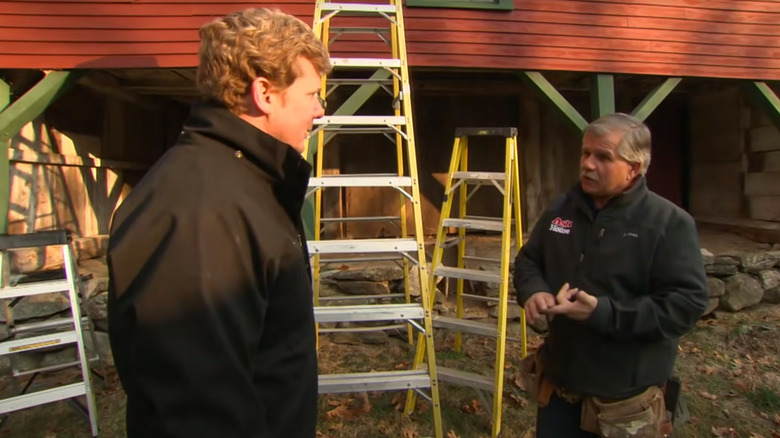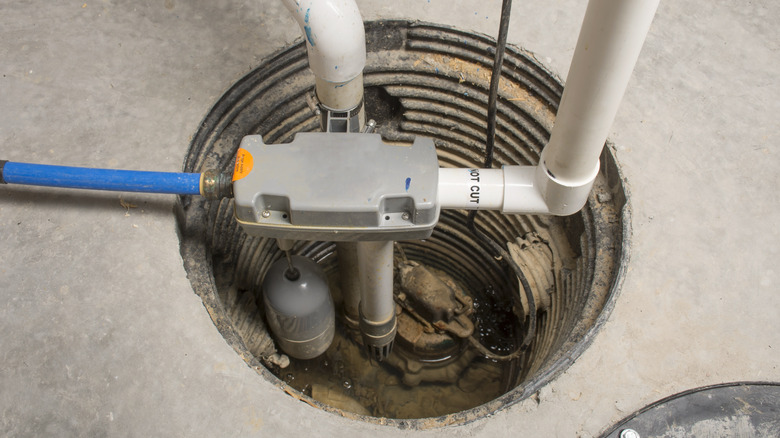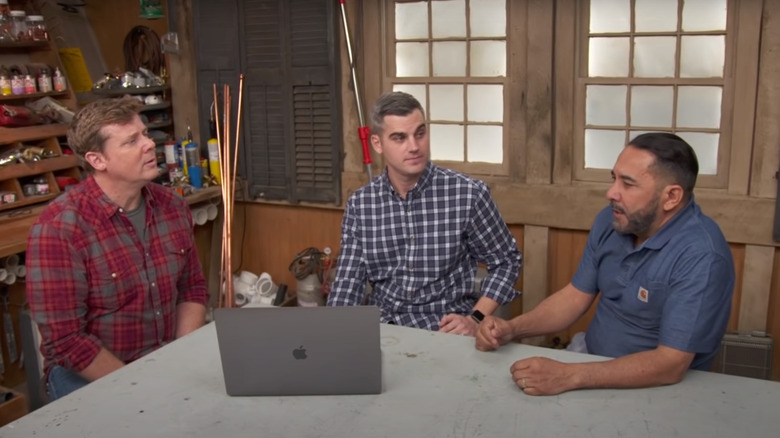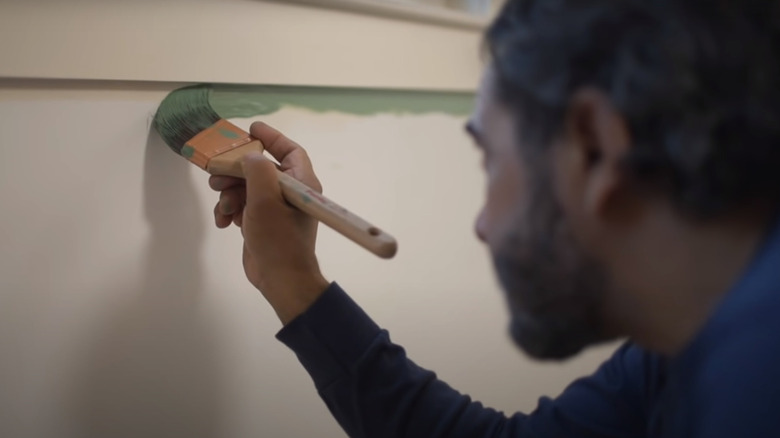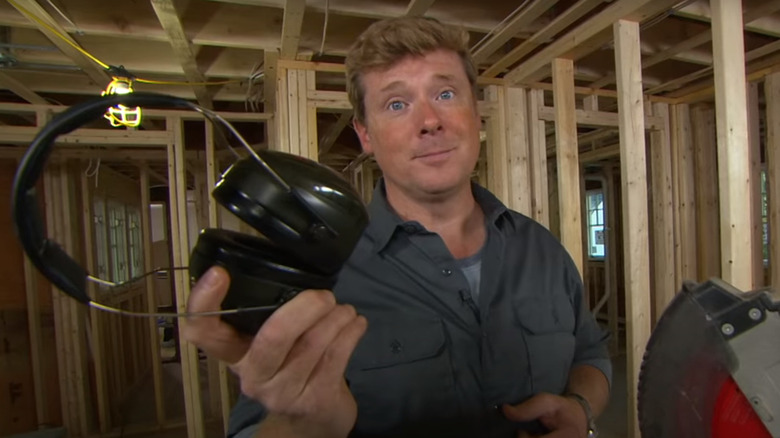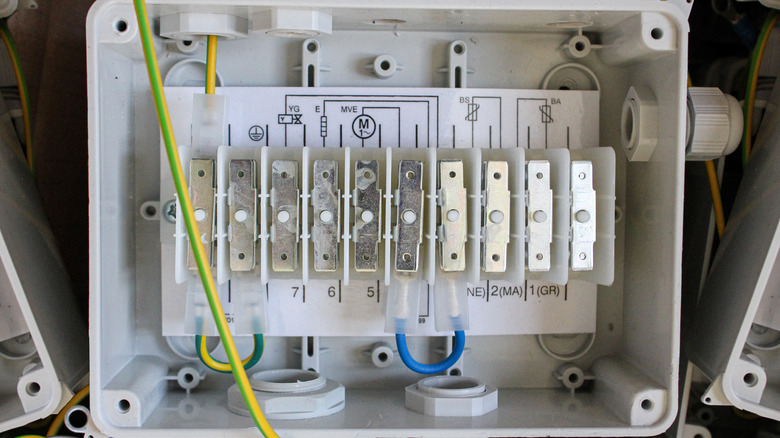Advice We Learned From This Old House That You Should Totally Avoid
Beloved by millions of Americans, the trailblazing home renovation show "This Old House" premiered on New Year's Day in 1979. Unlike more modern renovation shows, the PBS program focuses on flipping one house over the course of an entire season, rather than by the end of an episode.
"This Old House" is well-respected for generally providing accurate information about and an honest picture of the renovation process; its efforts have been recognized with almost two dozen Emmy Awards and over 100 nominations across multiple categories, per the show's website. Salon even praised the program's longevity as "smart, steady, and soundly educational for 40 years." Furthermore, The Atlantic argues that the entire modern genre of home improvement television owes its existence to "This Old House." However, even a show with a brand as strong as "This Old House" has had some missteps over the course of its 40 year history, intentional or not.
This Old House gives the impression that you can DIY everything
If you've seen enough episodes of "This Old House," it's easy to feel inspired to take on just about any project around the house on your own. The 30-minute episodes give bite-size repair and renovation advice, and end neatly with the work completed typically under budget and on time ... but don't be fooled. Even host Kevin O'Connor told Residential Tech Today that he's worried viewers might get the wrong idea because everything on TV looks way easier than it actually is. "It's human nature that a lot of homeowners start on projects and have no appreciation for how much work it is and how long it's going to take," he says. "The number one mistake is underestimating the cost and time that a project will take."
So, even if you've seen hundreds of episodes of "This Old House," before you start any major work on your home be sure to take a step back and realistically evaluate your budget and skillset. It might be worth it to give a licensed contractor a call for advice as well.
You can't usually ask your contractor to go over scope
Homeowners who appear on "This Old House" are often excited to have the show's expert contractors at their beck and call, and want to take full advantage of their knowledge and skills while filming. As per Boston Magazine, many homeowners would often be heard on set asking for "just one more thing" while the contractors were on site during filming. And, because it's a TV show, the "This Old House" team was usually happy to take a look and fix things up for the client. However, repeatedly asking your contractor to do work outside the scope of your agreement usually doesn't go as well when you're not on TV.
While the State Bar of Texas offers great resources on how to hire an ethical contractor and avoid getting scammed, according to Johnson and Wilson Real Estate, it is the responsibility of both the contractor and the homeowner to abide by the scope of work in order to deliver quality results on time and under budget. While contractors often expect small adjustments during the course of the project, asking the construction team to complete built-in bookcases in the living room while they remodel your kitchen shouldn't be done unless you officially adjust your contract to protect both parties.
Most jobs need more than one or two people
"This Old House" relies on a bit of movie magic when editing the work that goes into most of the renovations that appear on the show. As resident general contractor Tom Silva told Boston Magazine, "one of the projects recently grew almost double in size, and the last two months I had 30, 35 people working six days a week to try and bring it in on time. I did it, but it's a tough process." However, due to the program's tricky editing, viewers only get glimpses of the hard work that is done in the background by dozens of team members around the clock. This editing tends to give homeowners a false impression of not only a realistic timeline for the repairs they need done on their house, but also the actual amount of hands on deck needed to get everything finished correctly.
According to Kiplinger, "This Old House" isn't the only home improvement show that focuses on the general contractor, like Silva, while his massive team does all the actual work in the background. Still, viewers should be mindful about their lack of resources before starting a big project.
Buying an older house might not be doable for most people
"This Old House" makes even complex repairs and renovations look easy, giving the impression that purchasing a home in need of some fixing up is reasonable for most folks — but nothing is as ever as simple as it seems with older homes. According to The New York Times, the older the house, the more expertise you need to repair it. For example, if you purchase a 100-year-old home and the toilet stops working, you can't just replace it with a modern toilet and call it a day; the plumbing is incompatible, so it's a much bigger job than it seems at first.
And, as The Washington Post notes, even something as simple as stripping off older paint in preparation for work can be dangerous, as previous generations didn't have the same safety rules, and paint produced before 1978 is likely to contain lead (via the EPA). Because of the safety concerns of working with older materials and the potential avalanche of problems caused by simple mistakes, casual DIY enthusiasts might want to think twice before purchasing an older home in disarray.
Don't actually ditch the laundry chute
Popular design features come and go, depending on what's in fashion during the time of construction. One such feature is a laundry chute, a clever way to save time by allowing residents to drop dirty laundry directly from their bedrooms (or in some cases, the bathroom) into the laundry room without having to carry the possibly unsightly items through the halls of their home. Although it's not certain when the feature first gained popularity, an 1892 article in The New York Times mentions the "ingenious idea" popping up in tenement houses in New York City.
Bob Vila, contractor for the "This Old house," admires the convenience of the feature and said on his website that he regrets removing it from so many houses. So, even if you are living in a single family home and don't mind if your partner or children see your soiled clothes, removing the laundry chutes during renovation would be a shame, if only for the convenience of saving a trip up and down the stairs.
Don't remove ice dams on your own
While a snow dusted roof and icicles hanging from the eaves of your house is a picture perfect moment of winter, these conditions can also lead to a very expensive problem: ice dams. Ice dams are a big problem if you live somewhere with long, snowy winters. They are thick bands of ice that can collect under the eaves of your home. The eave is the part of the roof that hangs off over the wall.
According to the website for "This Old House," if left untreated, ice dams can cause major damage to your roof's shingles and even go on to cause major leaks and water damage to the inside of your home. This is correct, but the advice "This Old House" gives to take care of ice dams isn't. The Ice Dam Guys argue that the method recommended by "This Old House" (put salt in pantyhose to melt the dam) might actually damage the roof and won't work quickly enough to prevent an imminent leak. Instead, it's best to call in professionals right away so you're not stuck with an even larger roof repair bill come summertime.
You really need to wait before turning a refrigerator back on
A HomeOwnersHub member noticed that an older episode of "This Old House" showed contractors unplugging a refrigerator unit and immediately plugging it back in on site, which could damage it. Moversville reports that this mistake is often costly as when a refrigerator is moved, if it's not completely vertical, the oil in the fridge's compressor can move from its compressor tube into its coolant lines. This can happen even if the fridge is only on a slight angle. To avoid damage, the unit needs plenty of time for the oil to drain back to its original position, or there could be major compressor valve damage on start up.
While "This Old House" did not explicitly recommend the improper moving of refrigerators, viewers should always remember that the constant rolling of the cameras catches everything and the careless behavior of subcontractors in the background isn't always left on the cutting room floor. If you are going to follow advice from a home renovation show, be sure that it's explicitly given by the hosts and not just observed in the background.
Don't be careless with ladder safety
Bad behavior in the background of "This Old House" continues with the subcontractors' use of safety ladders in multiple episodes. The show's general contractor, Tom Silva, told HomeServe that his biggest pet peeve when filming on location is when his subcontractors ignore ladder safety rules and instead behave foolishly, using ladders backwards or failing to use the provided leg levels to achieve a stable foundation. These antics can lead to major injury or death, so it's best to avoid them.
In fact, according to the International Association of Certified Home Inspectors, there are more than 164,000 trips to the emergency room each year just because of ladder accidents. Additionally, in the United States alone there are 300 deaths from ladder falls each year — most of which occur from falls of 10 feet or less — which most people would not think could be fatal. To avoid becoming one of these statistics, it's best not to mimic Silva's subcontractors and instead take ladder safety seriously.
Avoid installing sump pump lines without considering discharge
An eagle-eyed member of the HomeOwnersHub noticed that some subcontractors on "This Old House" didn't plan ahead when installing a sump pump and failed to consider where the pump's drainage lines would run. This oversight caused them to scramble to avoid damage to the home.
To avoid any potential hazards, homeowners should always do plenty of planning before installing a sump pump, which is a pump installed at the lowest point of your home (like in your basement or crawlspace) to avoid flooding (via Len the Plumber). When installing, be sure that discharge lines are at a minimum of 2 feet below your area's frost line to avoid flooding from a frozen or clogged line, according to installation advice from Sump Pump Problem. To discover your local frost line and the correct installation depth, don't just eyeball it like the "This Old House" subcontractors did. Instead, contact your county records office for up-to-date building information, according to Charles + Hudson.
Don't buy an item just because it's on sale
Deborah Snoonian, Senior Editor at "This Old House," once bought a faucet for her kitchen sink because she liked it's chic color when she saw it at the store. It was a total impulse buy, encouraged by the appealing sale price of the item, but once she returned home, she began to realize that she'd actually made a big mistake. The fixture was far too short to be functional and she struggled to do basic tasks like fill pots with water. After a frustrating time, Snoonian had to buy a second, more functional faucet ... likely at full price.
Savvy homeowners would be smart to avoid falling into the trap of spending money on items for their home just because they are on sale. While saving money and shopping homewares sales is often ideal, it can have its downsides if you fail to properly research an appliance, faucet, or light fixture; it's highly likely that you could return home with a non-refundable, non functional item.
You shouldn't avoid plastering by painting instead
Deborah Hood, Producer on "This Old House" once made a similar mistake: spending less money at the onset and later costing herself much more due to her poor planning. During a house remodel, Hood and her husband replastered the walls of their dining room on their own in true "This Old House" fashion. While the work they did was good, the idea of doing the same painstaking labor on the ceiling was too overwhelming, so the pair decided to simply repaint the ceilings to avoid the work of plastering them.
However, even after they spent time and money painting the ceiling, it looked terrible and really detracted from the work Hood and her husband completed elsewhere in the room. So, they ended up needing to hire outside help to replaster the ceiling anyway, which was a huge expense in the end. Much like her colleague, Hood would have spent less money by planning out the project from start to finish, instead of trying to cut corners or purchasing things on impulse.
It's never okay to skip hearing protection
"This Old House" Host Kevin O'Connor is the first to admit that contractors foregoing proper hearing protection really bothers him, according to HomeServe. And unfortunately, O'Connor has seen the practice on plenty of job sites for the show.
This mistake is particularly heinous as the type of hearing loss acquired on construction sites is 100% permanent, and no amount of surgery or strength of hearing aids can bring it back, reports OSHA. In a recent survey, the CDC reported that roughly half of construction workers have been exposed to hazardous noise while on the job, and 31% of those exposed were not wearing correct ear protection at the time. An additional 14% of all construction workers in the United States have work-related hearing difficulty.
To avoid hearing loss, the American Society of Safety Professionals advises that construction forepeople maintain a safe worksite and require proper PPE of all workers while on location. It is commonplace to not be allowed entry to a work site without a hard hat, as it should be so without proper hearing protection as well.
You shouldn't bury a junction box inside a wall
A FineHomeBuilding user notes that one episode of "This Old House" showcases lead contractor Tommy Silva advising homeowners it's actually perfectly okay to bury a junction box deep inside a wall with no access point. A quick reminder: This isn't actually okay. In fact, it's a building code violation.
According to The Spruce, any wiring splices (where two or more wires are joined together) must be safely housed inside an electrical junction box. The box itself is required by building codes to remain fully accessible for emergencies, so it can't be covered up behind drywall, as seen on the show. Building code also dictates that the box's cover must be a solid blank without any holes, so that it doesn't conduct electricity.
Since "This Old House" has been airing for more than 40 years, it's understandable that there may have been some missteps. However, a seasoned contractor like Silva should know better than to advise homeowners to attempt a repair that isn't only a code violation, but also extremely unsafe.

